ASUS Maximus V Formula Z77 ROG Review
by Ian Cutress on March 25, 2013 2:30 PM EST- Posted in
- Motherboards
- Asus
- ROG
- Z77
Readers of our motherboard review section will have noted the trend in modern motherboards to implement a form of MultiCore Enhancement / Acceleration / Turbo (read our report here) on their motherboards. This does several things – better benchmark results at stock settings (not entirely needed if overclocking is an end-user goal), at the expense of heat and temperature, but also gives in essence an automatic overclock which may be against what the user wants. Our testing methodology is ‘out-of-the-box’, with the latest public BIOS installed and XMP enabled, and thus subject to the whims of this feature. It is ultimately up to the motherboard manufacturer to take this risk – and manufacturers taking risks in the setup is something they do on every product (think C-state settings, USB priority, DPC Latency / monitoring priority, memory subtimings at JEDEC). Processor speed change is part of that risk which is clearly visible, and ultimately if no overclocking is planned, some motherboards will affect how fast that shiny new processor goes and can be an important factor in the purchase.
For reference in this review, the ASUS Maximus V Formula does use MultiCore Turbo when XMP is enabled.
3D Movement Algorithm Test
The algorithms in 3DPM employ both uniform random number generation or normal distribution random number generation, and vary in various amounts of trigonometric operations, conditional statements, generation and rejection, fused operations, etc. The benchmark runs through six algorithms for a specified number of particles and steps, and calculates the speed of each algorithm, then sums them all for a final score. This is an example of a real world situation that a computational scientist may find themselves in, rather than a pure synthetic benchmark. The benchmark is also parallel between particles simulated, and we test the single thread performance as well as the multi-threaded performance.
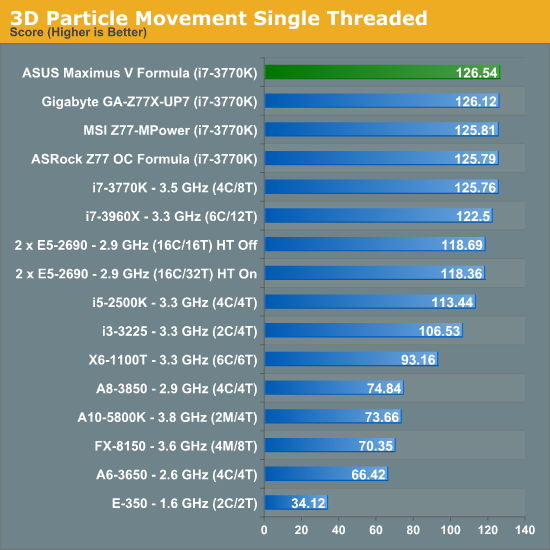
The MVF takes a nice lead in single threaded 3DPM, showing efficiency when not memory limited.
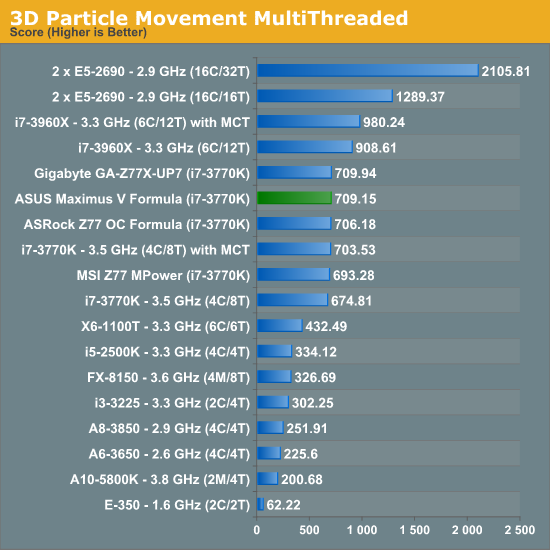
Still a good showing from the MVF in multithreaded 3DPM – clearly ahead of the ASRock and MSI, and only 0.1% behind the Gigabyte UP7.
WinRAR x64 3.93 - link
With 64-bit WinRAR, we compress the set of files used in the USB speed tests. WinRAR x64 3.93 attempts to use multithreading when possible, and provides as a good test for when a system has variable threaded load. If a system has multiple speeds to invoke at different loading, the switching between those speeds will determine how well the system will do.
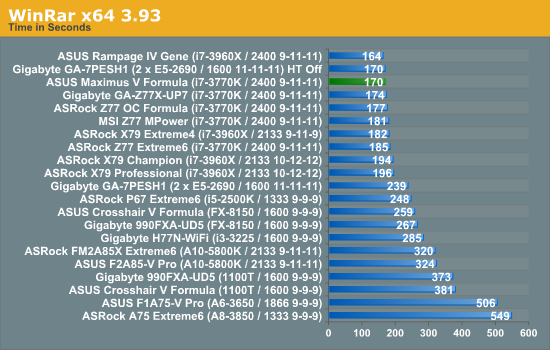
The ASUS MVF again shows efficiency, championing over the other OC motherboards by a noticeable about.
[Please note we are moving to a newer version of WinRAR shortly – 3.93 is still being used due to the number of results we have, and we are slowly retesting the older platforms.]
FastStone Image Viewer 4.2 - link
FastStone Image Viewer is a free piece of software I have been using for quite a few years now. It allows quick viewing of flat images, as well as resizing, changing color depth, adding simple text or simple filters. It also has a bulk image conversion tool, which we use here. The software currently operates only in single-thread mode, which should change in later versions of the software. For this test, we convert a series of 170 files, of various resolutions, dimensions and types (of a total size of 163MB), all to the .gif format of 640x480 dimensions.
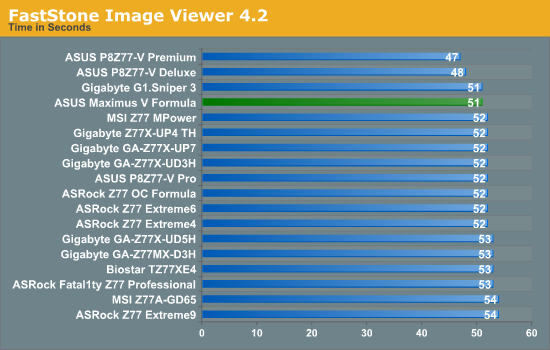
FastStone does not usually offer much in variation, although there is a clear split with the ASUS motherboards usually at the top, followed by Gigabyte then ASRock. MSI only have a few data points with no correlation (yet).
Xilisoft Video Converter
With XVC, users can convert any type of normal video to any compatible format for smartphones, tablets and other devices. By default, it uses all available threads on the system, and in the presence of appropriate graphics cards, can utilize CUDA for NVIDIA GPUs as well as AMD APP for AMD GPUs. For this test, we use a set of 32 HD videos, each lasting 30 seconds, and convert them from 1080p to an iPod H.264 video format using just the CPU. The time taken to convert these videos gives us our result.

In a similar set of events to FastStone, XVC shows Gigabyte and ASUS performing highly, with MSI then ASRock competing at the slightly slower speeds.
x264 HD Benchmark
The x264 HD Benchmark uses a common HD encoding tool to process an HD MPEG2 source at 1280x720 at 3963 Kbps. This test represents a standardized result which can be compared across other reviews, and is dependant on both CPU power and memory speed. The benchmark performs a 2-pass encode, and the results shown are the average of each pass performed four times.
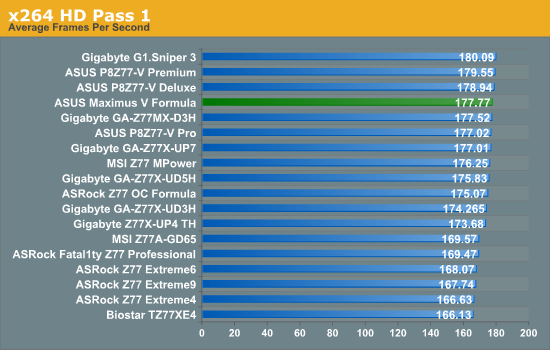











38 Comments
View All Comments
stefan from europe - Monday, March 25, 2013 - link
Thanks Ian for the review, but imo little late when in 2 months we have z87 on the way.Razorbak86 - Monday, March 25, 2013 - link
Take it up with Asus. They just sent him the board for review. Perhaps they should have participated in the Z77 mobo round-up conducted months ago?Jambe - Monday, March 25, 2013 - link
Quite the thoroughgoing review! Alas, I don't even consider standard ATX motherboards anymore, let alone EATX monsters.Still, it was a nice read, and the photos were lovely. That VRM cooler is neat...
Razorbak86 - Monday, March 25, 2013 - link
The MVF is only 0.5" wider than ATX, and exactly the same height as ATX. For that reason, it will easily fit in most mid-tower ATX cases. Full-size E-ATX boards (e.g., some server boards) can be up to 3" wider than standard ATX width.Jambe - Tuesday, March 26, 2013 - link
Mm, yes, but as I said, I don't bother with even standard ATX motherboards or chassis these days. I'd wager that mATX can provide what the vast majority of tech DIYers and enthusiasts and I'd further say that mITX can suffice for virtually everyone else.From my perspective it's just an economy issue: if one doesn't need and won't use the space and expansion options of standard ATX (or larger) motherboards & chassis, why bother with either?
Razorbak86 - Wednesday, March 27, 2013 - link
I wasn't trying to persuade you to buy the MVF. I was just trying to negate the implication that this board is an "EATX Monster", when it is actually much closer to ATX than EATX.vvk - Monday, March 25, 2013 - link
What is the point?Maybe I am little confused but considering Haswell is expected to come in 2months what is the point of buying this or any other ivy bridge MB now? Also considering how close all MBs game scores were investing in a better GPU would yield much grater benefits, per dollar.
5150Joker - Monday, March 25, 2013 - link
For people like me that built a desktop system a month ago and didn't want to wait on Haswell.scook9 - Tuesday, March 26, 2013 - link
Long time no see 5150Joker! I concur, I am reading this since I built my desktop in October with this board (with complete confidence in Asus) and wanted to see a good AT review to validate my decision :)noeldillabough - Tuesday, March 26, 2013 - link
And there is something to be said about a tested platform over a new unproven one. Bleeding edge causes some bleeding lol.